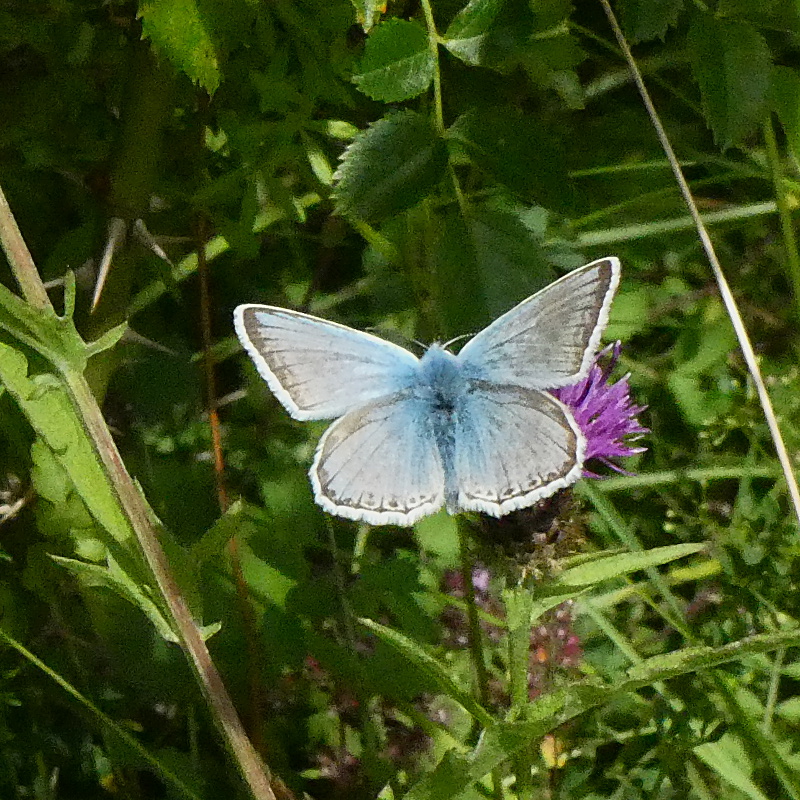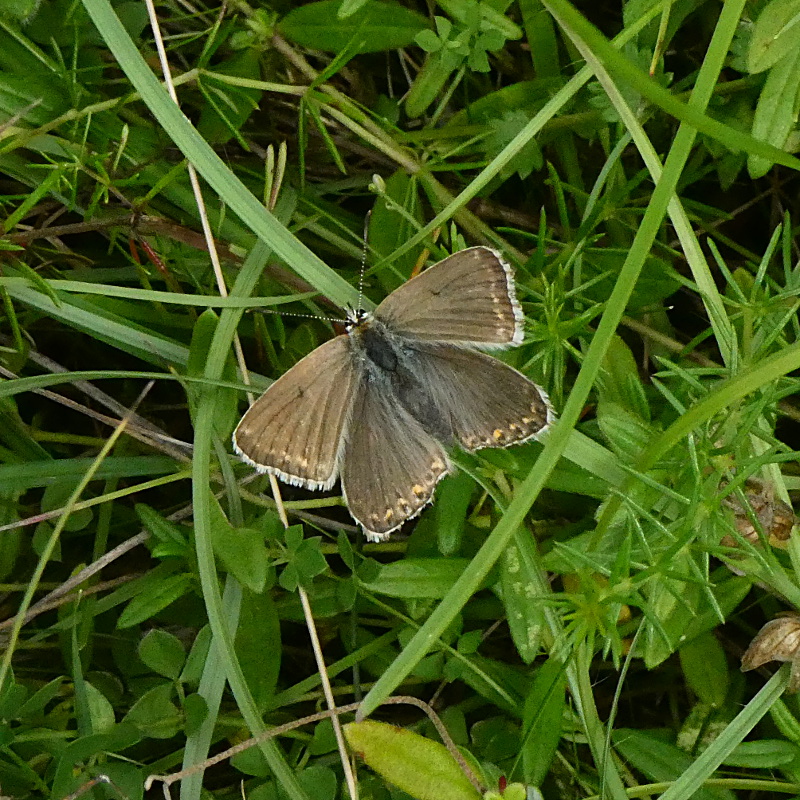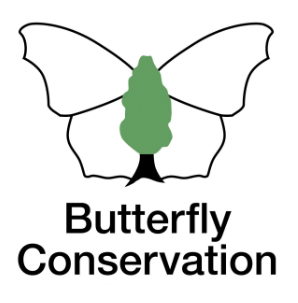Brown Argus
Brown Hairstreak
Chalkhill Blue
Clouded Yellow
Comma
Common Blue
Dark Green Fritillary
Dingy Skipper
Essex Skipper
Gatekeeper
Green Hairstreak
Green-veined White
Grizzled Skipper
Holly Blue
Large Skipper
Large White
Marbled White
Meadow Brown
Orange-tip
Painted Lady
Peacock
Purple Emperor
Purple Hairstreak
Red Admiral
Ringlet
Silver-washed Fritillary
Small Blue
Small Copper
Small Heath
Small Skipper
Small Tortoiseshell
Small White
Speckled Wood
Wall
White Admiral
White-letter Hairstreak
Extinct/rare immigrants
Chalkhill Blue
Polyommatus coridon
General Distribution and Status
This butterfly frequents chalk grasslands as the name suggests in the south of England from Gloucestershire in the west and Cambridgeshire in the east. Colonies can be very large, thousands in some places. In the 20th century, many colonies of the Chalkhill Blue were destroyed owing to the dying out of its larval foodplant, Horseshoe Vetch Hippocrepis comosa. The much reduced level of sheep and rabbit grazing on the chalk downs since the 1950s allowed the coarse grasses to dominate and eventually eliminate the foodplant. In the 1990s, increased conservation effort, for example by introducing selective grazing, coupled with fine weather revived the fortunes of the Horseshoe Vetch H. comosa and hence the butterfly. Although there was a slight decline at the turn of this century, since 2005 there has been a significant rise in abundance on monitored sites (Fox et al. ). However, since 2015 numbers have fallen once again with 2024 being the worst year on record. In Hertfordshire and Middlesex, the rise has been more dramatic with most of its old haunts re-colonised and good numbers today at Therfield Heath and Hexton Chalk Pit (Wood, 2016). Some dispersal is apparent because the high abundance has facilitated male specimens being discovered miles away from the chalk. However, numbers have dropped in the last few years probably due to poor weather in spring and early summer impacting larval developmenwt.
| United Kingdom | Herts & Middx | |||
| Distribution | 1976-2019 | -82% | 1980-2015 | +327% |
| Average 10-year trend | -31% | 2006-2015 | +67% | |
| 2024 since 2015-19 | 0% | |||
| Abundance | 1976-2024 | -14% | 1980-2015 | +504% |
| 2015-2024 | -11% | 2006-2015 | +226% | |
| 2023-2024 | -58% | 2024 since 2015-19 | -63% | |
UK distribution map
UKBMS Species summary
Habitat Requirements
Chalk as well as limestone grasslands harbour this species especially on south-facing slopes. The females are not too selective on which Horseshoe Vetch H. comosa plant to lay her eggs and can use all these plants on a site regardless of aspect (Heath et al.).
Larval Foodplants
Horseshoe Vetch Hippocrepis comosa.
Adult Food Sources
Wild Marjoram Origanum vulgare (15), Dung (10), Field Scabious Knautia arvensis (4), Common Knapweed Centaura nigra (3).
Historical Records
The Chalkhill Blue from Gibbs' 1902 report describes it as 'common on the downs in the north of the county' with records from Royston Downs (Therfield Heath), New Farm in St. Albans, Letchworth, Broxbourne Common and Aldbury Downs. Gibbs' 1904 report notes that specimens were seen in the Tring area on 26 July 1903. Around this time collectors from all round the country would visit Therfield Heath to find innumerable aberrations of the butterfly but by 1925 these aberrations had practically disappeared (Waterton 1982). Foster's 1934 report records it as 'used to occur at Wilbury Hill but now rarely seen there'. Roger Ferry caught a specimen in the Knebworth Woods complex on 17 August 1946 (Sawford). Waterton's 1970-81 survey mentions that 'it has become much less common by the 1970s and now exists in only one or two chalky areas north and west of the county'.
Local Distribution and Abundance
All sightings are from 2013 and 2014, at the Knebworth Woods complex and Great Ashby Park including five specimens on 5 September 2013 at the latter. They were probably all males which are known to disperse from breeding grounds in years when the butterfly is abundant. It is possible that these males originated from Hexton Chalk Pit about 10 miles away.

Life History
Earliest date: 17 July 2014 at Great Ashby Park
Latest date: 5 September 2013 at Great Ashby Park
The Chalkhill Blue produces
one generation a year with adults starting to emerge in the middle of July and peaking around the second week of August. Eggs are laid
singly on Horsehoe Vetch H. comosa stems or surrounding vegetation. Eggs hatch in spring in the following year. Secretions from the
larvae attract the attention of ants which provide some protection from predators. It is thought that pupae are often buried by the ants in the earth.
More details on the UK Butterflies website
Behaviour/Observation notes
It is a conspicuous butterfly with its milky-blue appearance. During spells of sunshine it flies rapidly just above the ground in between basking and feeding. In dull weather or during early morning or evening it will often bask or roost on tall vegetation affording good photographic opportunities.
Variations/Aberrations
The Chalkhill Blue is renowned for its aberrations as noted above but none of these forms have been reported in Hertfordshire in the
last 20 years or so. One female aberration, brown wings with a splattering of blue scales, ab. roystonensis was a form uniquely
found at Royston (Heath) by Mr. C. P. Pickett in the early 1910s (Pickett). With the increased abundance
of the insect in the recent past the chance of finding any aberration rises.
Find out more on the UK Butterflies website
References

Hexton CP (m) 11 Aug 2021

Hexton CP (f) 11 Aug 2021
Norton Green 14 Aug 2013 (m)



